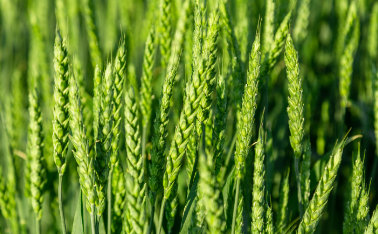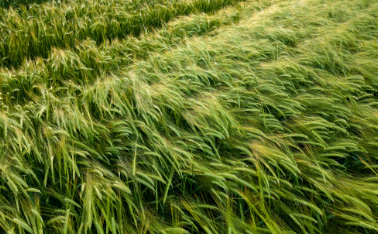Spring wheat – a brief description
Spring wheat, due to the shorter growing season, has a less developed root system and the highest soil requirements among all the cereals. For its cultivation, soils of a very good wheat complex, good wheat and mountain wheat complex are required. It is not very resistant to drought. Water shortage in the period from tillering to heading can cause a significant drop in yields. Growing spring wheat after grain crops results in a 15-20% lower yield. Beets, legumes, potatoes, broad beans and rapeseed are preferred as a forecrop.
Spring wheat sowing
Spring wheat requires very early sowing in order for it to flourish and develop a strong root system. It germinates at temperatures ranging between 1-3 degrees Celsius and is resistant to low temperatures down to -6 degrees Celsius. The optimal sowing date covers the period from the third decade of March to the first decade of April. Sowing date as well as sowing density depend on the light requirements of a given variety. In the case of varieties with high light requirements, too early sowing date or too high density results in a reduction in the number of spikelets and flowers in the spike. On the other hand, the advantage of dense sowing is that it minimizes the yield reduction under unfavorable conditions limiting tillering.
Spring wheat fertilization
The weaker root system of spring wheat determines the lower capacity of nutrient uptake, as well as a shorter period of accumulation of micro and macro elements. Cereals require precise fertilization balancing.
Spring wheat with a yield of 1t of grain and straw takes from the substrate: 30 kg N, 12 kg P2O5, 22 kg K2O, 6 kg CaO, 4 kg MgO; 9 kg of SO3.
It shows high sensitivity to Cu and Mn deficiency, especially at pH > 6.5 units.
Spring wheat is also sensitive to calcium deficiency. Liming with magnesium lime is recommended. A preferred form is the addition of a small amount of dolomite: 300-600 kg/ha.
Phosphorus-potassium fertilization of spring wheat
Phosphorus-potassium fertilizers on compact soils are best sown in autumn for plowing, while on lighter soils, they can be applied for spring pre-sowing cultivation. The doses of phosphorus and potassium fertilizers are determined on the basis of the results of soil analyzes and the expected yield. With the assumed grain yield of 5t/ha and medium soil fertility, it is best to use NPK fertilizers in a dose that will largely protect the nutritional requirements of spring wheat.
Additionally, it should be taken into account whether there were grains in the field before crops and whether the straw remains on the field to be plowed in, or if it is harvested from the field. When the straw remains, then we include a higher dose of potassium in fertilization. The P : K ratio should be 1 : 2.0 or 1 : 1.27. Before straw plowing, apply – regardless of the calculated nitrogen dose for wheat – 60 – 90 kg of urea per hectare. If straw is harvested from the field, the P : K ratio should be 1 : 1.5.
Plants properly nourished with phosphorus and potassium show better grain filling and uniform maturation.
Spring wheat fertilization with nitrogen
Nitrogen should be used at a dose of 20-30 kg/t of grain. Predicting the yield of 5 t/ha, we should specify 150 kg N/ha. Nitrogen is a very mobile component, therefore N doses should be applied to the soil in 2-3 times, not exceeding 60 kg at one time.
1st dose – 7-14 days before sowing: 50-60 kg/ha
2nd dose – start of shooting phase (first nod can be felt) – 40-60 kg
3rd dose – beginning of heading – 30-50 kg
Higher doses of nitrogen result in lodging of the wheat. At least one shortening in the final stage of tillering is essential. In areas with water shortages, it is advisable to use a large (70%) dose of nitrogen before sowing in the form of urea or UAN. On the other hand, urea or ammonium nitrate is recommended for top dressing.
Foliar feeding of spring wheat
Cu, Mn, Zn, Fe and Mo are the most important micronutrients necessary for the proper development and yielding of spring wheat. Their deficiency can significantly reduce the grain yield and affect its quality parameters. To avoid this, use dedicated microelement fertilizers with high concentrations of nutrients.
What are the benefits of fertilizing spring wheat?
Proper fertilization with phosphorus and potassium increases the resistance of spring wheat to diseases and water shortages. It determines the grain filling and uniform maturation. Proper nitrogen fertilization has a greater impact on the grain quality – the content of nutrients: total protein and gluten in the grain.
Summary
It is worth to follow our tips above if you want to grow spring wheat successfully. We also encourage you to read the article on fertilizing winter wheat!














